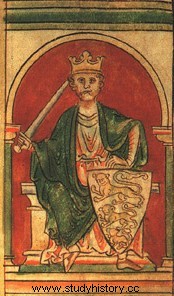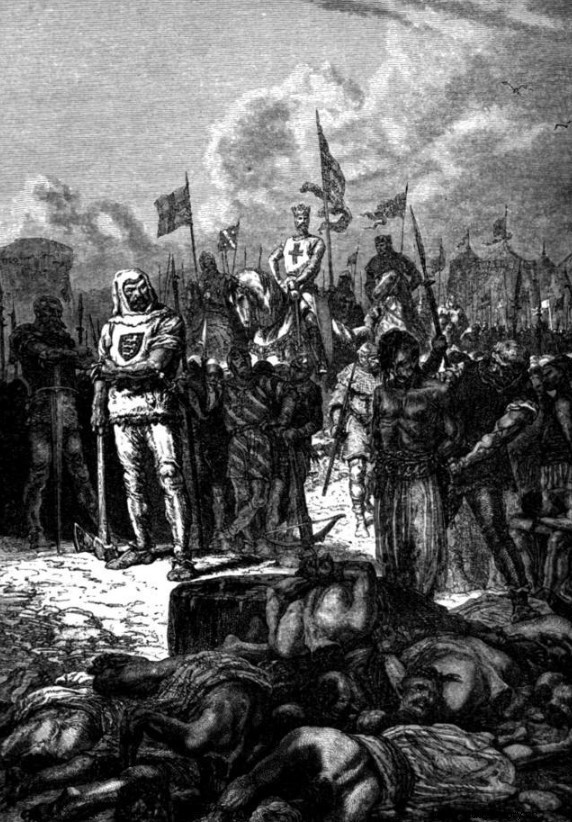When SMAP's "Lion Heart", which has been disbanded now, was released, it was broadcast on a large commercial, so I think that it is quite well known in Japan, Richard I of England.
Let's take a look at the second King of the Plantagenet dynasty, who boasts top-class fighting ability among all British kings and is also known as the Lionheart King.
Plantagenet Second King of the Dynasty
Richard I was born to Henry II, the founder of the Plantagenet dynasty, and his mother, Eleanor.
There are as many as eight children between Henry II and Eleanor, and Richard was born as the third son.
Her mother, Eleanor, was born of a leading French aristocrat, she was originally the queen of King Louis VII of France, and she was the heir to the vast territory of the Aquitaine region.
As a result, Henry II had vast lands in England, Anjou, and Aquitaine, and his relationship with the King of France was terrible.
Henry II ruled his land to his sons, but there were many enemies inside and outside of him, the biggest of which were his sons, including Richard.
His eldest son was deceased, so his second son Henry, his third son Richard, and his fourth son Eleanor rebelled against Henry II with the support of Kings of France and Scotland.
Henry II rebounded from such an allied force, but weakened when his second son Henry and his fourth son Jeffrey died of illness, and Richard teamed up with Philip II, the new King of France, to make Henry II. Henry is killed in a fierce battle.
In 1189, inheriting a vast land from his father, Richard was crowned King of England as Richard I.
Richard the Lion Heart

Around the time of Richard I's coronation, something happened in the distant land of Jerusalem.
It is said that the holy city of Jerusalem, the birthplace of Christ, fell by the hands of Muslims. The name of the leader is Saladin. He is later called the best Islamic lord.
Saladin, commonly known as Saladin, who was the Fatimid Caliphate, founded the Ayyubid dynasty with himself as king, and quickly took Egypt and Syria into his hands, and in 1187, the result of the First Crusade. The kingdom of Jerusalem has fallen.
Pope's Men's is crushed.
As a Christian leader, the Pope had to face an unbeatable battle.
Therefore, all the leaders of each country participate in the war, and the first and last Great Allied Forces in the history of Europe are formed.
King Richard I of England, King of the Lionheart, Frederick I, Holy Roman Emperor, King of Redbeard (Barbarossa), Philip II of France, King of Dignity (August), and other monarchs representing the European world go to Jerusalem. I marched toward.
In England, during the time of Henry II, a special tax called "Saladin's Tithe" was collected, and Richard I will do everything in his power.
However, when Barbarossa Frederick I drowned in Anatolia, his footsteps began to collapse, and King Philip II of France, who was worried about the decline of his power, left the battlefield and returned to the country. This significantly worsens the relationship between the Pope and the King of France and triggers a major event that will follow.
Despite the Pope's call, the European nations were not at all in line.
Richard I also became a battle between the Kingdom of Sicily and the Governor of Cyprus on the way, giving in to both.
When Richard I arrived in Syria, he and the Archduke of Austria attacked his key point, Acre, but again there was a disagreement, and the Archduke of Austria also returned to the country.
The cause of the discord is said to be that the English side dropped the flag built by the Archduke of Austria. Leopold V, Duke of Austria, has a grudge against England for this.
Occupying Acre kills all Islamic POWs, in contrast to Islamic Saladin, who never killed POWs.

Richard, as the nickname of Lion Heart, showed a divine talent in combat, and although he was able to defeat the Ayyubid dynasty in the Battle of Arsuf and the Battle of Jaffa, he was unable to recapture the main circle, Jerusalem.
In 1192, the Christian Union and the Ayyubid dynasty signed a peace treaty on the condition that unarmed Christians were allowed to pilgrimage to Jerusalem, and Richard I decided to return.
Brother's Rebellion and Captivity
While Richard was away, King Philip II of France was approaching Richard's younger brother John. John, called Lackland (no land), had no land. Henry II was trying to get John to take over the land, but Richard often interfered with it, and John was dissatisfied with it.
Philip II brilliantly got there, and John began to have the intention of seizing the throne.
Richard knew it and tried to return to England alone, but on the way he was caught in the hands of Archduke Leopold V of Austria. Leopold V, who had a case in Syria, handed over Richard's identity to Holy Roman Emperor Henry VI and demanded an exorbitant ransom of £ 100,000 from the English side. John ignores Richard and tries to take the throne himself, but he gets antipathy from the English forces and ends up paying the ransom.
The £ 100,000 is about seven times the national budget of the English royal family at that time.
Returning to Japan, Richard I is furious with his younger brother John, John atrophies, and Richard wants a direct confrontation with Philip II.
Richard I died in his 41-year life after being injured in a fierce battle.
Personal evaluation of Richard I
In fact, Richard I couldn't speak English at all. He valued his position as Count of Anjou more than King of England, and was rarely in England during his reign (only five were in England during his decade of reign). About a month). So his politics was done by Lord High Chancellor and Archbishop of Canterbury, Halbert Walter, and Richard's only thing was taxation.
As Richard's Lionheart (Cour de Lion in French), he spent all his time fighting, but this led to higher spending, which resulted in the dissatisfaction of the English princes, Magna Carta . Will lead to.
Richard was certainly strong in combat, but his victory did not bring anything to England, he merely defended the prestige of the Pope. It is no exaggeration to say that he is one of Britain's most incompetent kings politically.
By the way, it can be said that Richard I was almost the same age as Genghis Khan, Minamoto no Yoritomo, and Minamoto no Yoshitsune, and even in the same age group such as Saladin and Philip II, he was the top class in the command ability of battle.
Since the days of Mahomet, Christian forces have basically been pushed by the Islamic side, with very few victories up to this time. It was around the 17th century that the power relationship between the two began to reverse, and from the Christian side, Richard I's achievements in that he was not defeated by Islam may be said to be great.
After this, all the Crusader expeditions failed, and when the Ottoman Empire emerged, the Balkan Peninsula was occupied, and although the Iberian Peninsula was regained, it was pressed to Vienna in Australia.
Richard I's victory was one of the few on the Christian side.
